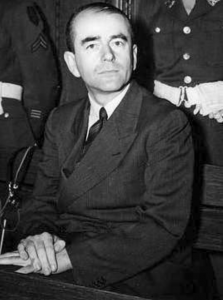Albert Speer, a significant figure in Nazi Germany, played prominent roles as Adolf Hitler’s chief architect and later as Minister of Armaments and War Production. Here, we explore the life, accomplishments, and controversies surrounding Albert Speer, delving into his association with the Nazi regime and the ethical questions raised by his actions.

Albert Speer’s early life and rise to prominence were shaped by his pursuit of architecture. Born on March 19, 1905, in Mannheim, Germany, he studied architecture at the Technical University of Berlin. It was during this period that Speer became affiliated with the Nazi Party, foreshadowing his future involvement with the regime.
Speer’s ascent began when he caught Adolf Hitler’s attention, leading to his appointment as Hitler’s personal architect in 1932. In this role, he undertook ambitious projects, such as the redesign of Berlin and the construction of monumental Nazi buildings that symbolized the regime’s power and aspirations.
However, Speer’s trajectory took a significant turn in 1942 when he assumed the position of Minister of Armaments and War Production. Tasked with optimizing Germany’s war economy, Albert Speer implemented innovative strategies to bolster arms production and enhance industrial efficiency.
Notwithstanding his achievements, Speer’s legacy is marred by the contentious issue of forced labor. While he claimed ignorance regarding the extent of Nazi atrocities, evidence suggests his complicity and knowledge of the use of forced labor from concentration camps and prisoners of war. This reliance on human exploitation tarnishes Speer’s reputation and raises profound ethical questions.
Following Germany’s defeat in World War II, Albert Speer faced justice at the Nuremberg Trials in 1945. Found guilty of war crimes and crimes against humanity, primarily due to his involvement in utilizing forced labor, he received a prison sentence of 20 years, narrowly escaping the death penalty.
During his imprisonment in Spandau Prison, Speer engaged in introspection and penned his memoirs, including “Inside the Third Reich” (1969) and “Spandau: The Secret Diaries” (1975). These writings provide insights into his motivations, actions, and the inner workings of the Nazi leadership, contributing to our understanding of this complex historical figure.
In conclusion, Albert Speer’s life is marked by a dichotomy of achievements and ethical dilemmas. His architectural accomplishments and subsequent role as Minister of Armaments continue to captivate scholars and the public alike. However, the shadow of forced labor and his association with the Nazi regime ensure that Speer’s legacy remains enigmatic, provoking ongoing debates and reflections on the moral responsibility of those in power.
Cite This Article
"Albert Speer: Architect, Minister, and Nazi" History on the Net© 2000-2024, Salem Media.
May 3, 2024 <https://www.historyonthenet.com/albert-speer-architect-minister-and-nazi>
More Citation Information.





